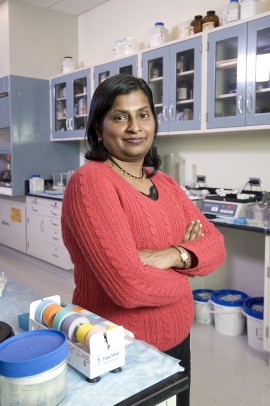Grant allows UIC oral biologists to further explore DMP1
The more Anne George learns about dentin matrix protein 1, the more unanswered questions she has.
George, Allen G. Brodie endowed professor of oral biology at the University of Illinois at Chicago, has received a $2 million federal grant to continue her research into DMP1, a gene that could play critical roles in bone and dentin mineralization.
Upon the conclusion of the five-year grant in 2019, George’s work on DMP1 will have been funded for 23 straight years by the National Institute of Dental and Craniofacial Research, one of the National Institutes of Health.
George was successful in cloning DMP1 in 1992, and since then she has been attempting to uncover its function. The current grant is based on her findings that the gene is not only involved in the mineralization function, but also in bone metabolism.
“Mineralization is a common process in nature and is fundamental to human development and health,” George said. “Dysfunctional mineralization leads to a variety of medical problems, so an understanding of these processes is essential.”
George and her laboratory recently discovered that DMP1 can stimulate the release of intracellular calcium from the endoplasmic reticulum (ER) in bone forming cells, called osteoblasts, and dentin forming cells, or odontoblasts. To refill the ER calcium, plasma membrane calcium channels need to be activated to permit entry from the extracellular space.
Regulation of calcium entry is necessary for the survival and differentiation of osteoblasts and odontoblasts.
“The molecular mechanism by which DMP1 stimulation mediates calcium release and maintains calcium homeostasis is a new concept that we’re investigating,” George said.
Two DMP1 interacting proteins – GRP-78 and TRIP-1 – have also been identified by George’s laboratory. Understanding the mechanism by which the proteins assist in bone and dentin formation is another area that will be studied by George and her colleagues.
Results from the research will have important implications in developing normal strategies for bone and dentin repair and regeneration, George said.
George’s research could lead to a new way of filling oral caries. Instead of using amalgam or other artificial compounds, dentists can fill the cavity with DMP1, which will bind calcium. After covering the site with polymer resin, new tissue would grow within a few weeks, allowing the dentin to regenerate.
The DMP1 gene cannot only regenerate dentin, but it can also be used as a signaling molecule that can convert stem cells into osteoblasts and help to repair bone fractures at a faster rate.
“We have long envied nature’s ability to design crystalline structures such as teeth and bone,” she said. “How dentin matrix protein 1 orchestrates the mineral growth process into structures with exceptional mechanical strength is fascinating. Nature is the best teacher, and we try to emulate and understand similar principles.”

